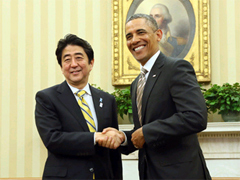 mofa.go.jp
mofa.go.jp As this article from Japan Today explains, Abe’s visit is one of only two visits by Asian leaders to be made this year. Who else is going to Washington? Why, no less than Chinese President Xi Jinping, that’s who. In a sense, this arrangement resembles that which Canberra experienced last year – the leaders of Asia’s two largest economies visiting to promote bilateral ties and further economic integration. Like last year, Abe will be getting in first, mostly likely to do a number of things.
The first of those things will be to ensure that the US is still committed to its pivot to Asia. Since the announcement in 2011, the US has made some effort towards shifting assets to the Indo-Pacific region, but clearly the region does not think that the US has done enough to increase its presence here. It is true that the US has been distracted somewhat by its own domestic political impasse and the events going on in Syria and Iraq, not to mention negotiations with Iran over its nuclear program, yet when an US administration makes an announcement on commitment, its allies expect that the US will, well, commit to it.
The second thing will be to discuss the establishment of the new Marine base at Henoko, and the eventual closure of the base at Futenma. In Japan of late, protests against the construction work taking place at Henoko have grown larger, with protestors taking to small sized vessels in an attempt to disrupt the building (and clashing with the Japan Coast Guard in the process). Abe might argue that the US should shoulder a larger burden for the construction costs, given that the base will primarily be for US use and that it will the Japanese government that will have to deal with the protests that will inevitably continue*.
The third thing will be to gain a sense of where the US is at in its own debate on the Trans-Pacific Partnership Agreement. Domestic debate on the subject in the US has stalled, and the concern of members of Congress of the agreement’s impact on American manufacturing means that a bill to enable President Obama to fast-track negotiations on trade deals is unlikely to appear in Congress until the Summer. Meanwhile PM Abe, whose own domestic agenda depends on increasing export markets for Japanese goods, has been watching events in Washington with a growing sense of concern. The trip will at least allow PM Abe to learn where President Obama stands on negotiations with Congress and how he might then have to explain this to Japan’s agriculture and business sector.
The fourth, and possibly the most controversial point, will be PM Abe’s chance to explain what he intends to do regarding his statement on the 70th anniversary of the end of WWII. This statement has been the source of a lot of speculation in Japan and abroad about what Abe plans to say, and whether it will placate or provoke Japan’s neighbours. Abe’s speech to the UN University in Tokyo on Monday should provide some indication, with Abe expressing the sincere remorse (that word again, taken from the Murayama Statement) of Japan over the war, and Japan’s progress since that time as a democratic nation dedicated to the rule of law and human rights (J). Nevertheless, there are some in the US who are concerned about Abe’s previous statements about Japan’s role in WWII, particularly the American Defenders of Bataan and Corregidor Memorial Society, who have written to Congress members to voice those concerns and urge Abe to acknowledge Japan’s actions.
Abe certainly plans to stay in the US for some time, undertaking an almost week-long visit to Washington, Boston, San Francisco and Los Angeles (originally Abe was to visit Honolulu and Pearl Harbour, but this was vetoed out of concern over backlash from within the US)(J). Abe may also find time to announce new initiatives aimed at boosting Japan studies in major US universities, the first time such measures will have been used in 40 years, and an obvious soft power move aimed at stemming some of the influence that China and South Korea have been exercising in US campuses in recent years.
Will it be a success? That depends on what Abe comes away with. The US may give its reassurances, but no firm promises with regard to either the TPP or base arrangements. That may prove difficult for Abe to sell domestically, but at the same time it will allow him to gauge just how much he can expect to rely on the US in the future. As one of the most travelled PMs in Japanese history, Abe may again start journeying abroad in search of new friends and allies.
*Some time ago I wrote about the impact of the Futenma base on Okinawa and the possibility of violence arising out of frustration by Okinawans at both the Japanese and US government intransigence over the removal of the base from Okinawa. Yesterday it was reported that a resident of Okinawa had begun making threatening phone calls against US Ambassador to Japan Caroline Kennedy, along with bomb threats against Camp Schwab in north eastern Okinawa. It’s a disturbing development, but not unanticipated. The only hope is that this individual was working alone (which he certainly appears to have been), and that these are not the actions of a group.
 RSS Feed
RSS Feed